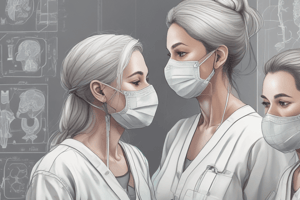Podcast
Questions and Answers
What is the primary importance of respiratory assessment?
What is the primary importance of respiratory assessment?
- To diagnose mental health disorders
- To identify respiratory problems and monitor treatment effectiveness (correct)
- To monitor cardiovascular health
- To assess nutritional status
What is observed during the inspection component of respiratory assessment?
What is observed during the inspection component of respiratory assessment?
- Blood pressure and pulse rate
- Respiratory rate and pattern, use of accessory muscles, and chest shape and movement (correct)
- Pain tolerance and sensitivity
- Chest X-ray results
What is assessed during palpation of the chest and lungs?
What is assessed during palpation of the chest and lungs?
- Oxygen saturation and pulse rate
- Nutritional status and body mass index
- Breath sounds and lung zones
- Chest expansion and symmetry, tactile fremitus, and crepitus or tenderness (correct)
What is identified during percussion of the lungs and chest cavity?
What is identified during percussion of the lungs and chest cavity?
What is assessed during auscultation of the lungs?
What is assessed during auscultation of the lungs?
What is measured and recorded during the vital signs component of respiratory assessment?
What is measured and recorded during the vital signs component of respiratory assessment?
What is obtained during the patient history component of respiratory assessment?
What is obtained during the patient history component of respiratory assessment?
What is performed during additional assessments of respiratory function?
What is performed during additional assessments of respiratory function?
Flashcards are hidden until you start studying
Study Notes
Respiratory Assessment
Importance of Respiratory Assessment
- Respiratory assessment is crucial in identifying respiratory problems and monitoring treatment effectiveness
- It helps in early detection of respiratory failure, which can lead to serious complications if left untreated
Components of Respiratory Assessment
1. Inspection
- Observe the patient's overall appearance, including:
- Respiratory rate and pattern
- Use of accessory muscles (e.g., neck, shoulder, and chest muscles)
- Chest shape and movement
- Presence of cyanosis or clubbing
2. Palpation
- Assess the patient's chest and lungs by feeling:
- Chest expansion and symmetry
- Tactile fremitus (vibrations felt during palpation)
- Crepitus (grating sensation) or tenderness
3. Percussion
- Assess the lungs and chest cavity by tapping:
- Identify areas of resonance, dullness, or hyperresonance
- Determine lung size and shape
4. Auscultation
- Listen to breath sounds using a stethoscope:
- Identify normal and abnormal breath sounds (e.g., wheezes, crackles, rhonchi)
- Assess lung zones and identify areas of abnormality
5. Vital Signs
- Measure and record:
- Respiratory rate
- Oxygen saturation (SpO2)
- Pulse rate
6. Patient History
- Obtain information about:
- Respiratory symptoms (e.g., cough, dyspnea, chest pain)
- Medical history (e.g., COPD, asthma, pneumonia)
- Medications and allergies
7. Additional Assessments
- Perform additional tests as needed, such as:
- Arterial blood gas (ABG) analysis
- Pulse oximetry
- Chest X-ray or CT scan
- Spirometry or pulmonary function tests (PFTs)
Respiratory Assessment
Importance of Respiratory Assessment
- Identifies respiratory problems and monitors treatment effectiveness
- Detects respiratory failure early, preventing serious complications
Components of Respiratory Assessment
Inspection
- Observes overall appearance, including:
- Respiratory rate and pattern
- Accessory muscle use
- Chest shape and movement
- Cyanosis or clubbing
Palpation
- Assesses chest and lungs by feeling:
- Chest expansion and symmetry
- Tactile fremitus
- Crepitus or tenderness
Percussion
- Assesses lungs and chest cavity by tapping:
- Identifies areas of resonance, dullness, or hyperresonance
- Determines lung size and shape
Auscultation
- Listens to breath sounds using a stethoscope:
- Identifies normal and abnormal breath sounds
- Assesses lung zones and identifies areas of abnormality
Vital Signs
- Measures and records:
- Respiratory rate
- Oxygen saturation (SpO2)
- Pulse rate
Patient History
- Obtains information about:
- Respiratory symptoms
- Medical history
- Medications and allergies
Additional Assessments
- Performs additional tests as needed, including:
- Arterial blood gas (ABG) analysis
- Pulse oximetry
- Chest X-ray or CT scan
- Spirometry or pulmonary function tests (PFTs)
Studying That Suits You
Use AI to generate personalized quizzes and flashcards to suit your learning preferences.




